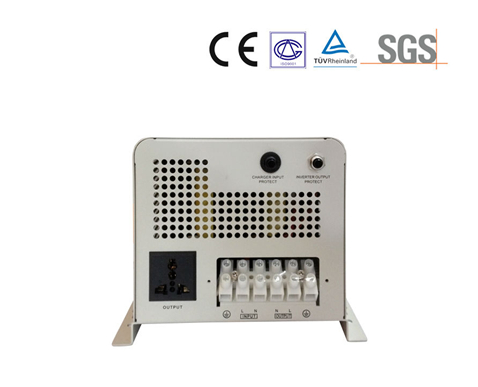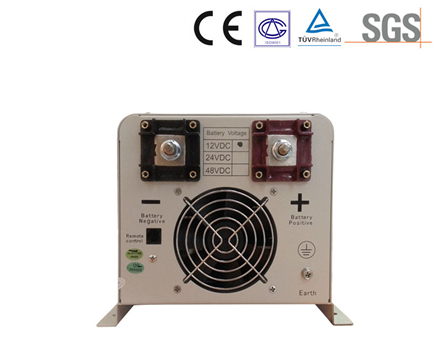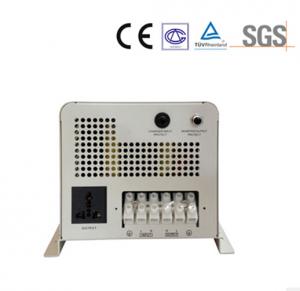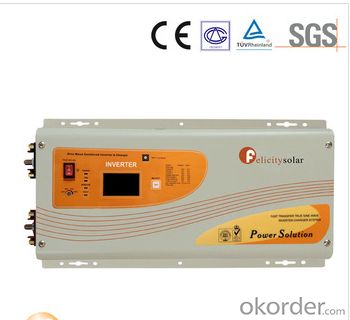Solar Inverter, 3.5kva 24V High Quality/Reasonable Price pure Sine Wave Solar Inverter
- Loading Port:
- Shanghai
- Payment Terms:
- TT or LC
- Min Order Qty:
- 400000 watt
- Supply Capability:
- 3000000 watt/month
OKorder Service Pledge
OKorder Financial Service
You Might Also Like
1. Structure of Solar Inverter, 3.5kva 24V High Quality/Reasonable Price pure Sine Wave Solar Inverter Description
The inverter series is an electronic product that has been designed and built to take low DC woltage power from batteries and convert it to
standard AC power like the current you have at home.
The Inverter series is a DC-to-AC with auto line-to-battery transfer and intergrated charging system. Inverter series powers from ACpower
and DC source, serving as an extended run UPS. When AC cable is connected to a wall socket, utility power goes to connected equipment
and/or charges the battery set via charging system. In Inverter mode, the Inverter series automatically converts battery energy into AC power
for backing up the connected devices.
2. Main Features of Solar Inverter, 3.5kva 24V High Quality/Reasonable Price pure Sine Wave Solar Inverter
• Super efficient, DC to AC conversion, minimizing charging losses
• Input Voltage rangeselect
• 5kva pure sine wave solar inverter
3. Solar Inverter, 3.5kva 24V High Quality/Reasonable Price pure Sine Wave Solar Inverter Images


4. Solar Inverter, 3.5kva 24V High Quality/Reasonable Price pure Sine Wave Solar Inverter Specification
Model | FL-IVP3524-3500VA |
Rated output power | 3500VA |
Max charge current | 35A |
Normal DC input voltage | 24V |
Nominal input power | 110Vac/120Vac/220Vac/230Vac |
Input voltage range | 96~132Vac/155~272Vac |
Charge current regulation | Charge current adjustable:25%,50%,75%,100%(Optional) |
Normal output frequency | 60Hz/50Hz |
Over load protection(SMPS) | Circuit breaker |
Output short circuit protection | Circuit breaker |
Efficiency | >95% |
Output voltage waveform | Pure sine wave |
5. FAQ of Solar Inverter, 3.5kva 24V High Quality/Reasonable Price pure Sine Wave Solar Inverter
Q1:Can we visit your factory?
A1:Sure,welcome at any time,seeing is believing.
Q2:Which payment terms can you accept?
A2:T/T,L/C,Moneygram,Paypal are available for us.
- Q: What is the role of a grid connection feature in a solar inverter?
- The role of a grid connection feature in a solar inverter is to enable the solar energy system to connect to the electricity grid. It allows for the transfer of excess energy generated by the solar panels back to the grid, thereby allowing the system to sell the surplus electricity or receive credits for it. Additionally, it ensures that the solar energy system can draw electricity from the grid when solar production is insufficient, ensuring a continuous and reliable power supply.
- Q: How does a solar inverter handle voltage and frequency variations caused by switching operations?
- A solar inverter is designed to handle voltage and frequency variations caused by switching operations through its built-in control mechanisms and advanced technology. When a solar inverter is connected to the grid, it monitors the voltage and frequency of the grid and adjusts its operation accordingly to maintain stability and safety. In the case of voltage variations caused by switching operations, a solar inverter typically employs a voltage control mechanism. This mechanism continuously monitors the voltage level of the grid and adjusts the output voltage of the inverter to match the grid voltage. If the grid voltage rises or falls beyond a certain threshold, the inverter automatically adjusts its output voltage to compensate and maintain a stable voltage level. Similarly, for frequency variations caused by switching operations, a solar inverter utilizes a frequency control mechanism. This mechanism constantly monitors the grid frequency and adjusts the inverter's output frequency to match the grid frequency. If the grid frequency deviates from the standard frequency, the inverter can quickly respond by adjusting its output frequency to maintain synchronization with the grid. To achieve this level of control, solar inverters often incorporate advanced digital signal processing algorithms and sophisticated control systems. These algorithms and control systems analyze the voltage and frequency signals from the grid, and based on predefined parameters, make rapid adjustments to the inverter's output to ensure compatibility with the grid. Ultimately, the goal of a solar inverter is to seamlessly integrate with the grid and provide a stable, reliable, and efficient power supply. By effectively handling voltage and frequency variations caused by switching operations, the inverter contributes to the overall stability and resilience of the grid, allowing for optimal utilization of solar energy and promoting a sustainable energy future.
- Q: Can a solar inverter be used in countries with different electrical standards?
- Yes, a solar inverter can be used in countries with different electrical standards. However, it may require certain modifications or adjustments to ensure compatibility with the local electrical infrastructure. Additionally, the input voltage and frequency of the solar inverter may need to be adjusted accordingly. It is important to consult with local experts or electricians to ensure proper installation and compliance with the electrical standards of the country.
- Q: What is the maximum DC input current of a solar inverter?
- The maximum DC input current of a solar inverter depends on its specifications and design. It can vary greatly depending on the model and capacity of the inverter. It is essential to refer to the manufacturer's documentation or specifications to determine the specific maximum DC input current for a particular solar inverter.
- Q: Can a solar inverter be used in conjunction with a power factor correction device?
- Yes, a solar inverter can be used in conjunction with a power factor correction device. The power factor correction device helps to improve the power factor of the electrical system, ensuring efficient and reliable operation. By installing a power factor correction device in combination with a solar inverter, the overall power quality can be enhanced, leading to optimized energy utilization and reduced electricity costs.
- Q: What is the lifespan of the capacitors in a solar inverter?
- The lifespan of capacitors in a solar inverter can vary depending on several factors such as the quality of the capacitors, the operating conditions, and the overall design of the inverter. However, on average, high-quality capacitors in a well-designed solar inverter can have a lifespan of around 10 to 15 years. Regular maintenance and proper usage can help extend the lifespan of the capacitors in a solar inverter.
- Q: How long do solar inverters typically last?
- Solar inverters typically last for around 10 to 15 years, although some high-quality inverters can last up to 20 years with proper maintenance and regular inspections.
- Q: Can a solar inverter be used in low light conditions?
- Yes, a solar inverter can be used in low light conditions. However, the efficiency of the inverter may be reduced as it relies on sunlight to convert the DC power generated by solar panels into AC power. In low light conditions, the solar panels produce less electricity, resulting in a lower output from the inverter.
- Q: Can a solar inverter be used with different types of solar PV systems (roof-mounted, ground-mounted, etc.)?
- Yes, a solar inverter can be used with different types of solar PV systems, including roof-mounted and ground-mounted systems. Solar inverters are designed to convert the DC (direct current) electricity generated by solar panels into AC (alternating current) electricity that can be used in homes or fed back into the grid. Regardless of the installation type, the solar inverter's function remains the same.
- Q: What is the role of a solar inverter in a solar-powered desalination system?
- The role of a solar inverter in a solar-powered desalination system is to convert the direct current (DC) electricity generated by the solar panels into alternating current (AC) electricity that can be used to power the desalination equipment. The inverter ensures efficient and safe power conversion, allowing the system to effectively utilize the energy generated by the solar panels for the desalination process.
Send your message to us
Solar Inverter, 3.5kva 24V High Quality/Reasonable Price pure Sine Wave Solar Inverter
- Loading Port:
- Shanghai
- Payment Terms:
- TT or LC
- Min Order Qty:
- 400000 watt
- Supply Capability:
- 3000000 watt/month
OKorder Service Pledge
OKorder Financial Service
Similar products
Hot products
Hot Searches
Related keywords

























